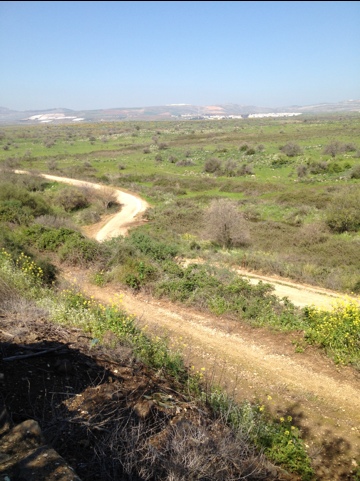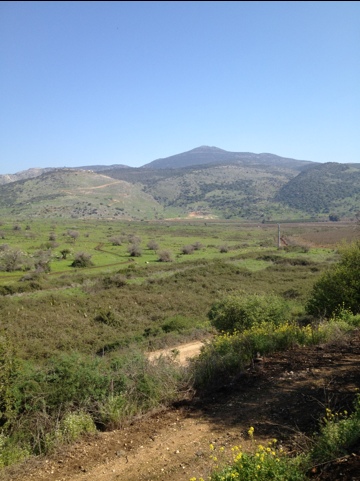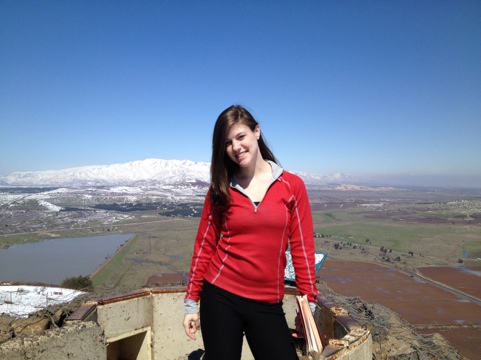“We’re still in a situation where we’re not sure where our borders are and we’re not sure who our citizens are, more than 60 years later.”
–A director of the Galilee Foundation, speaking in the Jewish settlement of Shorashim
Deep in the loose hills of the Golan Heights, both Israeli and Lebanese citizens live in the village of Ghajar. But the mix is not the result of deliberate cultural diversification; rather, it is an unintended consequence of an international peace-keeping border between the two nations that happens to run smack down the middle of Ghajar’s homes. This means that some members of the town began their lives as Syrian citizens, fell under Israeli control after Israel captured the Golan Heights from Syria in the 1967 war, and then found themselves in Lebanon as part of a truce facilitated by the United Nations in 2006. Over the course of one lifetime, the identity of this village has already shifted three times under three drastically different regimes.
We saw Ghajar in the distance today (you can see its faint white houses in my photo above) as we looked across the valley into Lebanon and then again into the old border with Syria (see below) and the new, far-more-dramatic-in-its-altitude border with Syria since 1967 (also below – please ignore the Jess-sized figure blocking the important view.) And though the actual border shifting (or, in Ethan’s words, shapeshifting) of Israel through the years did not come as a surprise to me after my Middle Eastern studies courses, the extra oomph of seeing it so intimately did, because it instantly brought the political banter down to a personal level. These changing lines on a map, which in America we only really experience in the form of gerrymandering voting districts, mean so much more here: they can be the difference between being able to freely visit family members in a different country and never seeing them again, or between living in a democracy or a dictatorship. Three feet — or, more accurately, meters — in either direction drawn on an international map alters the course of many more lives than the average Model UN team (or, for that matter, the actual UN itself) can easily comprehend.
And yet changing physical borders are such a norm here that every map that we have been given of Israel contains colored lines and dotted lines and explanations with asterisks in the margins. The realities of this physical instability only really became clear when I saw for the first time how SMALL Israel is. It’s about the size of New Jersey, and if you discount the disputed territories of Gaza and the West Bank, it is only about ten miles across at its narrowest point – for the record, that’s less than half of the distance that I used to drive to get to middle school each day and tiny enough for us to see from one end of the country to the other on a clear day. I mean no offense to the Jersey Shore fans when I share this, but I found myself agreeing with the person on our bus who wondered aloud: “How can an entire culture exist in something the size of New Jersey?” Now try and imagine if New Jersey kept ceding and reclaiming some of its land to and from New York on a regular basis and you can start to understand how crazy the border situation here really is.
The cultural boundaries in Israel, however, are even more mind-achingly complex than the physical ones, at least in my view. We spent the afternoon after today’s hike meeting with Israeli-Arabs of around our own age in the Jewish village of Shorashim and learning, through their stories, of the divisions that exist within Israeli society itself. Israeli-Arabs are Arabs who remained within the new state of Israel after its war of independence in 1948 and who became full Israeli citizens at that point (in contrast with the people whom we now refer to as Palestinians, who had a claim to the land that became Israel but who either fled or were driven out before the end of that war.) They make up about twenty percent of the country’s total population. Israeli-Arabs have the right to vote, to participate in Israel’s government and supreme court, to receive government services, etc. Yet even with their citizenship, they continue to live mostly separated from Jewish Israelis and most of them decide not to serve in the Israeli armed forces (they, unlike the remainder of the country with the exception of the ultra-Orthodox, are not required to enlist.) The majority of them attend different school systems and live in municipalities with smaller-than-average budgets. And some of them run into conflicts of allegiance almost daily. For example, for Arab-Israelis who are Muslim, it can be uncomfortable to salute a flag made up of Jewish symbols and to sing a national anthem proclaiming the glory of the Jewish people returning to Israel. It can also be difficult to avoid job discrimination (whether out and out discrimination by background or more obtuse discrimination by requiring certain levels of army achievement as part of professional qualifications), to achieve an equal education, and to be trusted as a day-to-day shopper in Jerusalem’s stores or a representative in the Knesset.
From Israel’s point of view, it is important to protect the rights of everyone in its democracy. Yet it needs to find a way to do so while still affirming its Jewish identity and catering its policies to prioritize Jewish success and growth, a goal that many politicians believe requires the maintenance of a Jewish majority within the entire state. Yet how can Israel laud its tolerant laws and approve extra support for Jewish settlement in the Galilee to equal out the growing number of Arab-Israeli living there, both at the same time? America has slowly repudiated the idea of “separate but equal”; can Israel find a way to do the same and still keep its legitimacy?
Before I end this post and its open-ended questions, I want to reiterate one more thing that was said today by our facilitator: “I am going to try to be objective, and fail.” I want to put out there in the open that I write these posts knowing that they are on sensitive topics and that I only know some of the facts. I write them knowing that my own opinions have been changing during each bus ride between destinations, and that there is often more power in what I don’t know yet than what I do. So excuse me for that, and please contribute your own knowledge and stories and opinions as they occur to you. Know that I am writing because I believe that something said and thought is better than nothing; that difficult and sometimes not politically-correct topics should not be abandoned merely for the discomfort that they can cause; and that I have a responsibility as a person who is getting a unique opportunity to see something “up close and personal” to, in turn, personalize that experience by offering up some of myself as I help to translate it for others.
Sweet dreams and open thoughts from a kibbutz in Galil,
J



